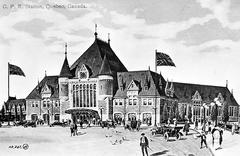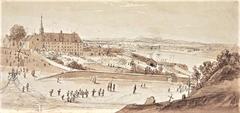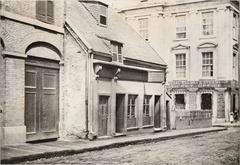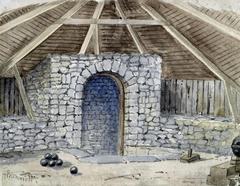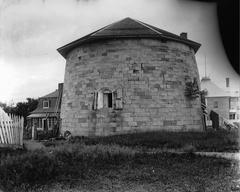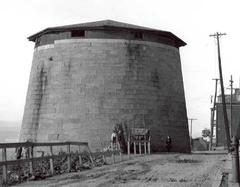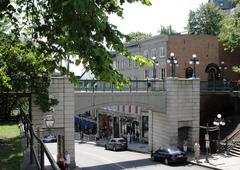
Île d’Orléans Bridge Visiting Hours, Tickets, and Quebec City Historical Sites Guide
Date: 04/07/2025
Introduction
The Île d’Orléans Bridge is more than a vital transportation link—it’s a symbol of heritage, innovation, and scenic beauty connecting the historic Île d’Orléans to Quebec City across the Saint Lawrence River. Since opening in 1935, the bridge has fostered regional development, cultural exchange, and tourism, making Île d’Orléans accessible year-round. As the region prepares for a new, state-of-the-art cable-stayed bridge to meet modern needs, visitors continue to be drawn by the island’s unique blend of history, gastronomy, and rural landscapes. This guide provides detailed information on visiting hours, accessibility, ticketing, travel tips, and the bridge’s historical and architectural significance, ensuring you make the most of your visit to this iconic Quebec landmark (Quebec Aventure Tours; Historic Bridges).
Table of Contents
- Historical Evolution and Bridge Significance
- The New Cable-Stayed Bridge: Features & Sustainability
- Visiting Hours, Tickets, and Accessibility
- Travel Tips and Exploring Île d’Orléans
- Frequently Asked Questions (FAQ)
- Summary and Visitor Recommendations
- References and Further Reading
Historical Evolution and Bridge Significance
From Ferries to the 1935 Steel Truss Landmark
Before 1935, access to Île d’Orléans depended on ferries and seasonal ice bridges, making transportation unpredictable and limiting economic development. The inauguration of the steel truss bridge, designed by engineers Philip Louis Pratley and C.C. Monsarrat, ushered in a new era of year-round connectivity. Its construction during the Great Depression was a major public works achievement and helped solidify the island’s role as Quebec’s agricultural heartland and historical epicenter (Wikipedia; Historic Bridges).
Modernization Needs
Over time, the bridge has faced increasing demands, with daily crossings peaking at up to 15,000 vehicles in tourist seasons. However, its narrow lanes, lack of pedestrian and cycling infrastructure, and structural aging present safety and accessibility challenges (Quebec Government). These limitations have prompted the launch of the $2.7 billion new cable-stayed bridge project, scheduled for completion in 2028 (Renew Canada; CBC).
The New Cable-Stayed Bridge: Features & Sustainability
Design and Symbolism
The new bridge, designed by the Groupement Origine Orléans consortium, features elegant V-shaped pylons, a slender profile to harmonize with the landscape, and panoramic belvederes. Its design is a tribute to the island’s maritime heritage and the French cultural roots of the region (EXP; Stantec).
Structural and User Features
- Length: 2.1 kilometers, built west of the existing bridge.
- Traffic: Two wide lanes and wide shoulders for increased safety.
- Active Mobility: Dedicated multi-use paths for pedestrians and cyclists on both sides.
- Belvederes: Four observation points offering views of the St. Lawrence River, Montmorency Falls, and Quebec City.
- Lighting: Nighttime illumination accentuates its architectural lines.
Sustainability Integration
The project incorporates climate adaptation measures, green spaces, and sustainable mobility infrastructure. Environmental impact assessments guide construction, ensuring minimal disruption to the river ecosystem and rural landscapes (Stantec).
Engineering and Community Collaboration
Internationally renowned engineers and architects, including Michel Virlogeux and Thomas Lavigne, have helped ensure the new bridge meets world-class standards. The project is shaped by extensive public consultation to balance local needs, heritage preservation, and environmental stewardship (EBC Inc.; Gowling WLG).
Visiting Hours, Tickets, and Accessibility
Visiting Hours
- Current Bridge: Open 24/7 for vehicles. Pedestrian and cyclist access is possible but limited due to narrow sidewalks.
- New Bridge (from 2028): 24/7 access for vehicles; multi-use paths for pedestrians and cyclists open daily from dawn to dusk (Authentik Canada).
Tickets and Entry
- No Tickets/Tolls: Crossing the bridge (by car, bike, or on foot) is free.
- Guided Tours: Several local operators offer paid tours that include bridge crossings and curated island experiences.
Accessibility
- Current Bridge: Limited accessibility for wheelchairs and strollers; caution advised for pedestrians and cyclists.
- New Bridge: Fully accessible, with wide, smooth multi-use paths, gentle gradients, rest areas, and clear signage.
Travel Tips and Exploring Île d’Orléans
Getting There
- By Car: The bridge is accessed via Highway 440 East from Quebec City; parking is available near the bridge and at tourist sites.
- By Public Transit: Seasonal shuttle services and limited bus routes are available.
- By Bicycle: Experienced cyclists can cross the current bridge, but the new bridge will offer safer, dedicated lanes.
Exploring the Island
- Chemin Royal: A 70-kilometer scenic loop connecting the island’s six historic villages.
- Villages: Each municipality (Saint-Pierre, Sainte-Famille, Saint-Laurent, Saint-Jean, Saint-François, Sainte-Pétronille) offers distinct heritage sites, artisan shops, churches, and panoramic viewpoints.
- Gastronomy: The island is famous for strawberries, apples, cideries, vineyards, microbreweries, and sugar shacks (Authentik Canada).
- Outdoor Activities: Cycling, hiking, and photography are popular, with numerous trails and lookout points.
- Seasonal Highlights: Spring maple syrup season, summer festivals and farm visits, autumn foliage and harvest events, winter snowshoeing and ice wine tastings.
Visitor Services
- Tourist Office: Located near the bridge in Saint-Pierre, open daily with extended hours in summer. Offers maps, booking assistance, and local recommendations.
- Facilities: Restrooms are limited; parking is available at the tourist office and most churches.
- Accommodations: Range from inns and boutique hotels to campgrounds; booking ahead is advised in peak season.
- Inclusivity: The region is safe and welcoming for all visitors, including LGBTQ+ travelers (Queer Adventurers).
Frequently Asked Questions (FAQ)
Q: What are the visiting hours for the Île d’Orléans Bridge?
A: The bridge is open 24/7 for all users.
Q: Is there a toll or ticket required?
A: No, the bridge is free to cross by any mode of transport.
Q: Is the bridge safe for pedestrians and cyclists?
A: The current bridge has limited sidewalks; caution is advised. The new bridge will have dedicated, safe paths.
Q: Are there guided tours?
A: Yes, several local operators offer guided tours of the island, including transportation over the bridge.
Q: What are the best times to visit?
A: Summer and autumn are most popular for festivals and vibrant landscapes; spring offers maple syrup experiences.
Q: Where can I get real-time updates and travel tips?
A: Download the Audiala app and follow local tourism websites for current information and event schedules.
Summary and Visitor Recommendations
The Île d’Orléans Bridge stands as a remarkable blend of heritage and innovation—connecting visitors to historic villages, vibrant agricultural traditions, and the breathtaking landscapes of Quebec. With the new cable-stayed bridge on the horizon, the region’s accessibility, safety, and visitor experience will be further enhanced. Plan your trip to coincide with seasonal highlights or cultural festivals, use the Chemin Royal for a scenic tour, and explore the island’s artisanal and gastronomic offerings. For up-to-date information and interactive maps, consult the official tourism resources or the Audiala app (Quebec Aventure Tours; CBC).
References and Further Reading
- Quebec Aventure Tours: How to Get to Île d’Orléans from Quebec City
- Top100Projects.ca: Île d’Orléans Bridge Project
- Gowling WLG: Île d’Orléans Bridge Replacement
- Authentik Canada: Practical Guide to Île d’Orléans
- Renew Canada: New Île d’Orléans Bridge Construction
- EBC Inc.: New Bridge Project Announcement
- Historic Bridges: Île d’Orléans Bridge Details
- Quebec Government: New Bridge Construction Project
- CBC News: Quebec Île d’Orléans Bridge Construction
Explore More:
- Check our Quebec City historical landmarks guide and top cycling routes in Quebec.
- Download the Audiala app for interactive maps, real-time updates, and guided tours.
- Follow us on social media for the latest news and travel inspiration.
Recommended visuals: Include high-quality images of the Île d’Orléans Bridge, Chemin Royal, and island villages, with descriptive alt tags for accessibility and SEO.




